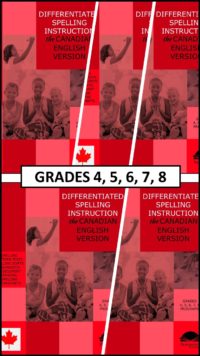Canadian Spelling Instruction

Spelling Programs for Canadians
Canada is fortunate to have two official languages, and both Canadian French (Quebec, Acadia, and Métis) and Canadian English have significant dialectical variations. However, the vast number of pronunciations, spellings, grammar, and word meanings are quite similar. Even the differences are not universally accepted within Canada. Canadian dictionaries occasionally disagree about spellings. Regional spellings differ, as do those in academic and popular press.
With respect to the similarities and differences between Canadian and American English spellings, technological communication (including spell check) has standardized many spellings. However, because language is dynamic, it’s fair to say that many of the newer words, and hence their spellings, are uniquely Canadian. For example, The Canadian Oxford Dictionary, first published in 1999, added over 5,000 words in its 2005 second edition. According to editor Katherine Barber, this new edition “features 2,200 uniquely Canadian words and senses, 350 usage notes, 7,000 idiomatic expressions, 5,500 biographical entries, and over 5,600 place names.”
That being said, most spelling patterns are quite consistent between Canadian and American English. Canadians often muse about their spelling inconsistencies; however, the vast majority of Canadian spelling patterns are quite regular and dependable. That being said, most spelling patterns are quite consistent between Canadian and American English.
Because most popular spelling programs in Canada use purely American spellings, Canadian teachers have to identify words such as “colour,” “theatre,” and “traveling” as exceptions, not the rule. A strange message for Canadian children that their spelling system includes non-preferred spellings!
As an American author of five popular spelling programs, I see the importance of validating the language(s) of one’s country. Language is the key cultural component, and Canadian children deserve to learn Canadian French and Canadian English. With regard to the latter, I decided to completely re-write my American English Differentiated Spelling Instruction programs to include Canadian sound-spellings and spelling patterns. It was quite a deep dive into the British-American-Canadian orthographical systems! Quite interesting for a spelling nerd, Yours Truly. Call me an American spelling imperialist, but less ethnocentric. I invite you to check out the programs.
Differentiated Spelling Instruction (the Canadian English Versions) features 30 weekly grade-level spelling word lists and tests based upon instructional spelling patterns. No silly themed lists, such as the Canadian provinces, colours, etc. Each spelling pattern has a corresponding spelling sort. Quarterly summative assessments with progress monitoring matrices help teachers monitor individual and class mastery of the grade-level spelling patterns.
To address the needs of diverse learners, the program provides the comprehensive whole-class Diagnostic Spelling Assessment with recording matrix to help teachers individualize spelling instruction. This assessment includes paper copies or Google Forms and Sheets formats. The corresponding remedial Spelling Pattern Worksheets explain the spelling pattern, provides examples, includes a spelling sort, has a word jumble, rhyme, and/or book search, and includes a short formative assessment to determine whether or not the student has mastered the spelling pattern. Students self-correct the worksheet to learn from their mistakes and mini-conference with the teacher, who corrects the formative assessment to determine mastery. If mastered, the teacher marks as such on the Diagnostic Spelling Assessment Mastery Matrix.
Now that’s effective differentiated instruction! Your students can catch up, while they keep up with grade level spelling instruction with Differentiated Spelling Instruction (the Canadian English Versions.

The Teaching Reading Strategies (Intervention Program) is designed for non-readers or below grade level readers ages eight–adult. This full-year, 55 minutes per day program provides both word recognition and language comprehension instructional resources (Google slides and print). Affordable, easy-to- teach, and science of reading-based, featuring the Sam and Friends Phonics Books–decodables designed for older students. The word recognition activities and decodables are also available as a half-year option in The Science of Reading Intervention Program.
PREVIEW TEACHING READING STRATEGIES and THE SCIENCE OF READING INTERVENTION PROGRAM RESOURCES HERE.

